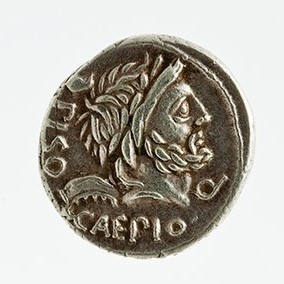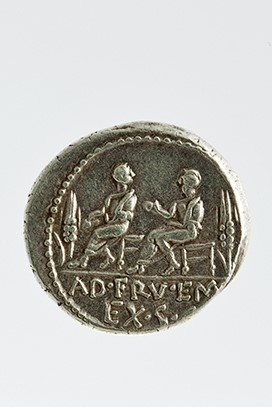Title: Denarius of L. Calpurnius Piso Caesoninus and Q. Seruilius Caepio - 1991.01
Acquisition number: 1991.01
Author or editor: Beryl Rawson
Culture or period: Roman Republic
Date: 103-100 BC
Material: Metal - Silver
Object type: Coins - Roman
Dimensions: 17mm (w)
Origin region or location: Italy
Origin city: Rome
Display case or on loan: 5
Keywords: Coin, denarius, Roman, Republic, Saturn, Roman Britain
Sear, D.R., Roman Coins and their Values 5 vols (London, Spink, 2000-2014) 210; Crawford, M., Roman Republican Coinage 2 vols (Cambridge, Cambridge University Press, 2011) 330/1; Sydenham, E. A. The Coinage of the Roman Republic (London, Spink, 1952; (Sanford J. Durst repr. 1976) 603, 603A; Seaby, H.A., Roman Silver Coins (London, B.A. Seaby, 1967) Calpurnia 5, 5a; Grueber, H.A., Coins of the Roman Republic in the British Museum 3 vols (London, The Trustees of the British Museum, 1910; rev. edn London, 1970) I. 1125-28.
1991.01
Denarius of L. Calpurnius Piso Caesoninus and Q. Seruilius Caepio
3.94 g. 103-100 BC
Obv.: Head of Saturn r.; behind, a sickle; below, control symbol (bow?). PISO (downwards) CAEPIO Q(uaestores) (in exergue).
Rev.: two quaestors sitting on bench between ears of grain. AD FRV(mentum) EMV(ndum) EX S(enatus) C(onsulto) in exergue.
The issue of this coin is connected with grain shortages in Rome towards the end of the second century BC.
In 104 BC the senate transferred responsibility for the grain supply from L. Appuleius Saturninus, ‘quaestor for Ostia.’, because of a rise in the price of grain, to a very senior senator, M. Aemilius Scaurus, as special commissioner. (This episode is plausibly presented by Colleen McCulloch in her novel The First Man in Rome.) Grain supplies were being threatened by a slave revolt in Sicily.
Saturninus then put through a law to reduce the price of grain, probably as tribune of the plebs in 103 BC. There was violence, led by the city quaestor Q. Seruilius Caepio, who argued that the cost to the treasury was too great. His colleague as quaestor, named on this coin, was L. Calpurnius Piso Caesoninus (the father of the consul of 58 BC of the same name, who was father of Calpurnia, wife of Julius Caesar), probably the quaestor for Ostia.
The senate authorised funds for a special purchase of grain, as recorded in the reverse legend, ‘the purchase of grain in accordance with a senatorial resolution’. This was either to compensate the people for the loss of Saturninus' benefit (if his law was defeated), or to implement that law. The sources for Saturninus and associated events are conflicting and not contemporary: see Broughton, including his Volume III (Supplement) 1986.
Saturn was the god in whose temple the Roman treasury was located. The sickle depicted with him strengthened the association with funds for the grain supply. This association is made explicit on the reverse in the words of the legend and the symbols of ears of grain and of quaestors (financial officials).
It is striking that so comparatively early, when Roman coins still bore largely conventional types (cf. other second century coins, showing helmeted head of Roma or Jupiter or Victory in a chariot), this coin should advertise the food supply question in such personal detail.
The food supply for Rome (a city which grew to a population of more than a million inhabitants) continued to be of great importance through the Republican and Imperial periods. Ostia, at the mouth of the Tiber River, became a great port only 150-200 years after this coin.
Sear, D.R., Roman Coins and their Values 5 vols (London, Spink, 2000-2014) 210; Crawford, M., Roman Republican Coinage 2 vols (Cambridge, Cambridge University Press, 2011) 330/1; Sydenham, E. A. The Coinage of the Roman Republic (London, Spink, 1952; (Sanford J. Durst repr. 1976) 603, 603A; Seaby, H.A., Roman Silver Coins (London, B.A. Seaby, 1967) Calpurnia 5, 5a; Grueber, H.A., Coins of the Roman Republic in the British Museum 3 vols (London, The Trustees of the British Museum, 1910; rev. edn London, 1970) I. 1125-28.

